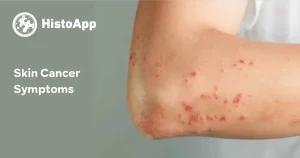


07 Apr 2025
Skin cancer is the 17th most common cancer globally, and its incidence is rising due to factors like increased sun exposure and tanning bed use. However, when detected in the beginning stages of skin cancer, it is highly treatable.
Early detection of skin cancer gives you the greatest chance to protect yourself from the beginning stages of skin cancer and ensure successful skin cancer treatment.
In this blog, let’s explore what skin cancer is, its types, skin cancer symptoms, and how digital pathology is transforming diagnosis in the digital age.
Skin cancer develops when abnormal skin cells grow uncontrollably, primarily due to exposure to ultraviolet (UV) radiation from the sun.
There Are Three Main Types of Skin Cancer on the Face:
Basal cell carcinoma (BCC) is one of the most common skin cancer types that often develops on areas of skin exposed to the sun. It often appears as a pearly or waxy bump on the face, like skin cancer on the nose, ears, or neck.
It’s very rare for basal cell cancer to spread to other parts of the body, but it can become locally invasive, grow wide and deep into the skin and destroy skin, tissue and bone when treatment is inadequate or delayed
Squamous cell carcinoma (SCC) is the second most common type of skin cancer, marked by the abnormal and accelerated growth of squamous cells.
The first sign of a Squamous Cell Carcinoma is often a thickened, red, scaly spot on your skin that doesn’t heal. You can most likely find it on the back of your hands, forearms, legs, scalp, ears or lips. It is usually not life-threatening but can spread to other areas if not treated early.
Melanoma is a type of skin cancer that develops when melanocytes, the cells that give the skin its tan or brown colour, start to grow uncontrollably. It is known as one of the most dangerous skin cancer types. It also has an important warning sign, such as the development of skin cancer moles or the appearance of new dark spots on the skin.
While Melanoma is a serious skin cancer as it can spread quickly to other organs, it’s highly curable if caught early.

According to the World Health Organization (WHO), early diagnosis of skin cancer focuses on identifying symptomatic patients as soon as possible so they will be more likely to have the best chance for successful treatment. When cancer care is delayed or difficult to access, survival rates decrease, treatment complications increase and healthcare costs rise.
Early Detection of Skin Cancer improves cancer outcomes by facilitating care at the earliest possible stage, making it an important public health strategy in all contexts.
Skin cancer is one of the most common types of cancer worldwide, but the good news is that when detected early, it is often highly treatable.
It’s very well known that the stages of skin cancer range from I (1) through IV (4). Fortunately, the lower the number, the less the cancer has spread.
That’s why a regular skin cancer check is one of the best ways to detect early stage skin cancer.

The most common warning sign of skin cancer is a change in your skin, typically appearing as a new growth or a change in an existing mole.
Skin Cancer Symptoms Could Be:
Skin cancers can look quite different from one person to another as they appear in many shapes and sizes, which makes them challenging to identify.
While skin cancer pictures can help you learn what skin cancer can look like, getting to know your own skin and understanding what to look for can help you detect cancer early, when it’s easiest to cure.
That’s why patient needs to examine their skin once a month if they see something new, changing, or unusual. When they get it checked by a professional pathologist right away, they are more likely to find and treat skin cancer early and save their lives.

There’s no doubt that protecting yourself from the beginning stages of skin cancer is crucial for your health. By understanding the types of skin cancer, recognizing skin cancer symptoms, and performing regular self-examinations, you can catch early stage skin cancer before it becomes a serious problem.
Digital pathology is revolutionizing cancer diagnosis by using pathology software to analyze and store biopsy images electronically. Instead of relying on traditional microscope-based analysis, specialists can now use advanced pathology lab technologies for faster and more precise results.
And Here Comes HistoApp’s Part.
HistoApp is at the forefront of digital pathology, offering innovative solutions for cancer detection through a cutting-edge digital pathology online platform.
By leveraging advanced pathology software and digital pathology tools, HistoApp provides a comprehensive platform for the early detection and diagnosis of skin cancer.
Here is How HistoApp Can Help You Detect Skin Cancer Early
Whole slide scanners create detailed images of skin biopsies, allowing pathologists to examine tissue samples with more accuracy and precision.
Advanced algorithms analyze skin cancer pictures and detect abnormalities that may be missed by the human eye.
A professional Pathology Laboratory uses HistoApp’s platform to store and organize data, making it easier to track and analyze skin cancer cases.
By identifying early stage skin cancer, HistoApp helps ensure timely treatment and better outcomes for patients.
Read More About:

- OR -
You can make us a free call through our website, press the button below and start the call
Call Us now